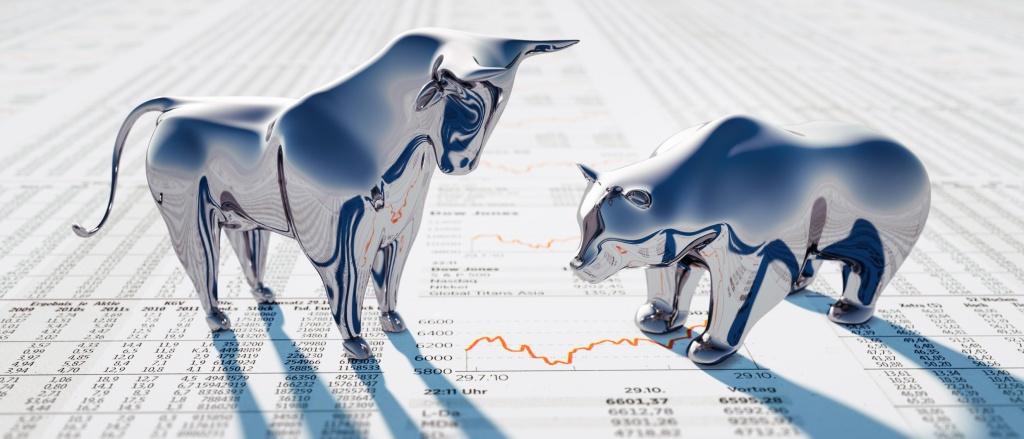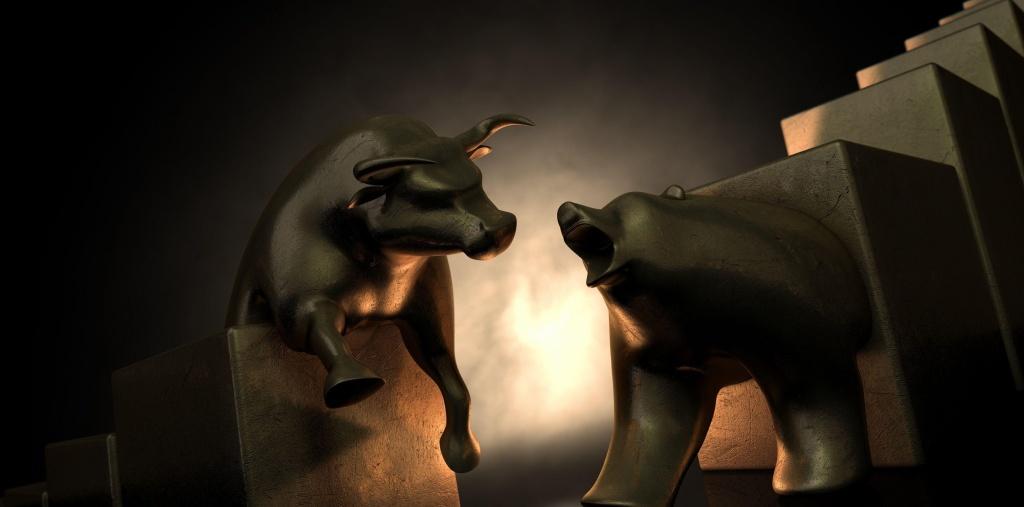The crypto market is known for its high volatility and unpredictability, which can lead to massive price swings and market cycles. These cycles are often described as bull and bear seasons, depending on whether the market is trending upwards or downwards. In this article, we will explore what these terms mean, what factors influence them, and what strategies investors can use to navigate them.
What is a Bull or Bear Market?
A bull market is a period of time where the majority of investors are buying, demand outweighs supply, market confidence is high, and prices are rising. A bull market is often driven by positive news, innovation, adoption, and speculation. Investors who believe that prices will increase over time are known as “bulls”.
A bear market is a period of time where supply is greater than demand, confidence is low, and prices are falling. A bear market is often triggered by negative news, regulation, hacks, or market manipulation. Investors who believe that prices will continue to fall are known as “bears”.
Both terms are borrowed from the stock market, where they are used to describe the general direction of the market over a long period of time. However, in the crypto market, these terms can also be applied to shorter time frames, such as weeks or months.
What Causes Bull and Bear Seasons in the Crypto Market?
The crypto market is influenced by many factors, both internal and external. Some of the most common ones are:
- Supply and demand: The basic economic principle of supply and demand determines the price of any asset. When more people want to buy than sell, the price goes up. When more people want to sell than buy, the price goes down.
- Market sentiment: Market sentiment refers to the overall mood and attitude of investors towards the crypto market. It can be measured by various indicators, such as social media activity, trading volume, volatility, and news coverage. Market sentiment can create a positive or negative feedback loop, where rising prices attract more buyers, and falling prices scare away more sellers.
- Innovation and adoption: The crypto market is constantly evolving with new technologies, products, and services that aim to improve the efficiency, security, and usability of the industry. These innovations can attract more users, investors, and developers to the crypto space, creating more demand and value for the underlying assets.
- Regulation and legislation: The crypto market is subject to various rules and regulations from different jurisdictions around the world. These rules can have a significant impact on the legal status, taxation, and compliance of crypto activities. Depending on how favorable or unfavorable these rules are, they can either boost or hinder the growth and adoption of the crypto market.
- Competition and cooperation: The crypto market is composed of hundreds of different projects and platforms that compete for market share and user attention. However, they can also cooperate with each other through partnerships, integrations, and interoperability. Competition can drive innovation and differentiation, while cooperation can create synergies and network effects.
- External events: The crypto market is not isolated from the rest of the world. It can be affected by various events that happen outside of the industry, such as global politics, economics, social movements, natural disasters, pandemics, etc. These events can influence the demand and supply of crypto assets, as well as the risk appetite and sentiment of investors.

What Happened in the Previous Bull and Bear Seasons?
The crypto market has gone through several bull and bear seasons since its inception in 2009. Here are some of the most notable ones:
- 2011: Bitcoin reached its first major peak of $32 in June 2011 but crashed to $0.01 shortly after due to a security breach at Mt.Gox exchange. It took 20 months for Bitcoin to recover to its previous high.
- 2013-2014: Bitcoin surged to over $1,000 in November 2013 but entered a prolonged bear market that lasted until January 2017. The main factors behind this decline were regulatory crackdowns in China and other countries, as well as the collapse of Mt.Gox exchange, which resulted in the loss of 850,000 BTC.
- 2017-2018: Bitcoin reached its all-time high of nearly $20,000 in December 2017, driven by a wave of innovation, adoption, and speculation. However, the market soon reversed and entered a brutal bear market that saw Bitcoin drop to below $4,000 in December 2018. The main factors behind this crash were regulatory uncertainty, market manipulation, hacks, and investor fatigue.
- 2020-2021: Bitcoin rebounded from the COVID-19 induced crash in March 2020 and entered a massive bull run that took it to over $63,000 in April 2021. The main factors behind this rally were institutional adoption, innovation, stimulus measures, and social media hype. However, the market also experienced several corrections and volatility along the way, with Bitcoin dropping to below $30,000 in June 2021. The main factors behind this decline were environmental concerns, regulatory pressure, market sentiment, and profit-taking.
What to Expect in 2023 and 2024?
It is impossible to predict the future of the crypto market with certainty, as there are many unknown variables and risks involved. However, based on some historical patterns and current trends, we can make some educated guesses and scenarios.
One possible scenario is that the crypto market will continue its bull run in 2023 and 2024, reaching new highs and surpassing the $100,000 mark for Bitcoin. This scenario could be supported by the following factors:
- Halving effect: Bitcoin undergoes a halving event every four years, where the block reward for miners is cut in half. This reduces the supply of new bitcoins entering the market, creating a supply shock that can drive up the price. The last halving occurred in May 2020, and historically, Bitcoin has reached new peaks about a year after each halving.
- Institutional adoption: More and more institutional investors, such as hedge funds, pension funds, corporations, and governments are entering the crypto space, either as direct buyers or as service providers. These institutions bring more capital, credibility, and stability to the market, creating more demand and value for crypto assets.
- Innovation and adoption: The crypto industry is constantly developing new technologies and solutions that improve the scalability, security, and usability of the market. These include layer-two solutions, decentralized applications, decentralized finance (DeFi), non-fungible tokens (NFTs), central bank digital currencies (CBDCs), etc. These innovations can attract more users, investors, and developers to the crypto space, creating more network effects and value for the underlying assets.
- Regulatory clarity: The crypto market is gradually maturing and becoming more regulated and compliant with global standards. This can reduce the uncertainty and risk associated with crypto activities, as well as open up more opportunities for mainstream adoption and integration. More countries are also recognizing and embracing the potential of crypto assets as a new asset class and a source of innovation.
Another possible scenario is that the crypto market will enter another bear market in 2023 and 2024, falling below its previous lows and stagnating for a long period of time. This scenario could be triggered by the following factors:
- Black swan event: A black swan event is an unpredictable and catastrophic event that has a severe impact on the market. Examples of such events include global wars, pandemics, natural disasters, terrorist attacks, etc. These events can cause panic and fear among investors, leading to a massive sell-off and loss of confidence in the market.
- Regulatory crackdown: The crypto market is still facing significant regulatory challenges and resistance from some governments and authorities around the world. Some countries may ban or restrict crypto activities altogether or impose harsh taxes or penalties on them. These actions can deter or prevent investors from participating in the market or force them to exit at a loss.
- Hacks or security breaches: The crypto market is still vulnerable to cyberattacks or security breaches that can compromise the integrity or availability of crypto platforms or assets. These incidents can result in the loss or theft of funds or data, as well as damage the reputation and trust of the industry.
- Market saturation or competition: The crypto market is becoming more crowded and competitive with hundreds of new projects and platforms launching every year. However, not all of them will survive or succeed in the long run. Some may fail due to technical issues, lack of innovation or adoption or funding issues. Others may lose their competitive edge or market share to better or newer alternatives. This can lead to a consolidation or elimination of many crypto projects and platforms, reducing the diversity and value of the market.

Which Projects and Coins Should Be Considered the Most in a Possible Bull Season Scenario?
There is no definitive answer to this question, as different investors may have different preferences, goals, and risk profiles. However, some general criteria that could help investors identify potential winners in a bull market are:
- Fundamentals: The fundamentals of a project or coin refer to its underlying technology, vision, team, community, partnerships, etc. These factors determine the long-term viability and value proposition of the project or coin, as well as its ability to solve real-world problems and create positive social impact.
- Performance: The performance of a project or coin refers to its historical and current price action, market capitalization, trading volume, liquidity, etc. These factors indicate the popularity and demand of the project or coin, as well as its potential for future growth and profitability.
- Innovation: The innovation of a project or coin refers to its ability to introduce new features, products, or services that improve the efficiency, security, or usability of the crypto industry. These innovations can create competitive advantages and differentiation for the project or coin, as well as attract more users, investors, and developers to the crypto space.
- Trends: The trends of a project or coin refer to its alignment with the current and emerging trends and themes in the crypto market. These trends can include technological developments, regulatory changes, social movements, etc. These trends can create more opportunities and demand for the project or coin, as well as increase its relevance and influence in the industry.
Based on these criteria, some examples of projects and coins that could perform well in a bull market are:
- Bitcoin (BTC): Bitcoin is the first and most dominant cryptocurrency in the market. It is widely regarded as a store of value, a hedge against inflation, and a digital gold. Bitcoin has strong fundamentals, such as its limited supply, decentralized network, and robust security. It also has high performance, as it is the most liquid and widely traded cryptocurrency in the market. Bitcoin is constantly innovating with new solutions such as layer-two scaling, privacy enhancements, and smart contracts. Bitcoin is also aligned with the trends of institutional adoption, mainstream integration, and social awareness.
- Ethereum (ETH): Ethereum is the second-largest cryptocurrency by market capitalization and the leading platform for decentralized applications (DApps), decentralized finance (DeFi), and non-fungible tokens (NFTs). Ethereum has strong fundamentals, such as its smart contract functionality, developer community, and network effects. It also has high performance, as it is the most active and diverse platform in the market. Ethereum is constantly innovating with new solutions such as layer-two scaling, proof-of-stake consensus, and sharding. Ethereum is also aligned with the trends of innovation and adoption in the crypto industry.
- Binance Coin (BNB): Binance Coin is the native token of Binance, the largest and most popular cryptocurrency exchange in the world. Binance Coin has strong fundamentals, such as its utility value, governance rights, and deflationary mechanism. It also has high performance, as it is one of the top-performing cryptocurrencies in the market. Binance Coin is constantly innovating with new solutions such as Binance Smart Chain (BSC), Binance Launchpad, and Binance NFT. Binance Coin is also aligned with the trends of exchange growth, platform expansion, and ecosystem development.
- Cardano (ADA): Cardano is a third-generation blockchain platform that aims to provide a more scalable, secure, and sustainable platform for smart contracts and DApps. Cardano has strong fundamentals, such as its peer-reviewed research, formal methods, and proof-of-stake consensus. It also has high performance, as it is one of the fastest-growing and most anticipated platforms in the market. Cardano is constantly innovating with new solutions such as smart contracts, governance, and interoperability. Cardano is also aligned with the trends of social impact, academic collaboration, and global adoption.
- Polkadot (DOT): Polkadot is a multi-chain platform that aims to provide a scalable, interoperable, and secure platform for cross-chain communication and collaboration. Polkadot has strong fundamentals, such as its relay chain, parachains, bridges, and governance. It also has high performance, as it is one of the most advanced and ambitious platforms in the market. Polkadot is constantly innovating with new solutions such as parachain auctions, crowdloans, and cross-chain composability. Polkadot is also aligned with the trends of interoperability, decentralization, and innovation.
Conclusion
The crypto market is a dynamic and complex environment that can offer both opportunities and challenges for investors. By understanding the concepts of bull and bear seasons, the factors that influence them, and the strategies to navigate them, investors can make more informed and rational decisions in the market. However, investors should also be aware of the risks and uncertainties involved in the crypto market, and always do their own research and due diligence before investing.
This article is not financial advice or a recommendation to buy or sell any cryptocurrency. It is for informational purposes only and should not be construed as such.





